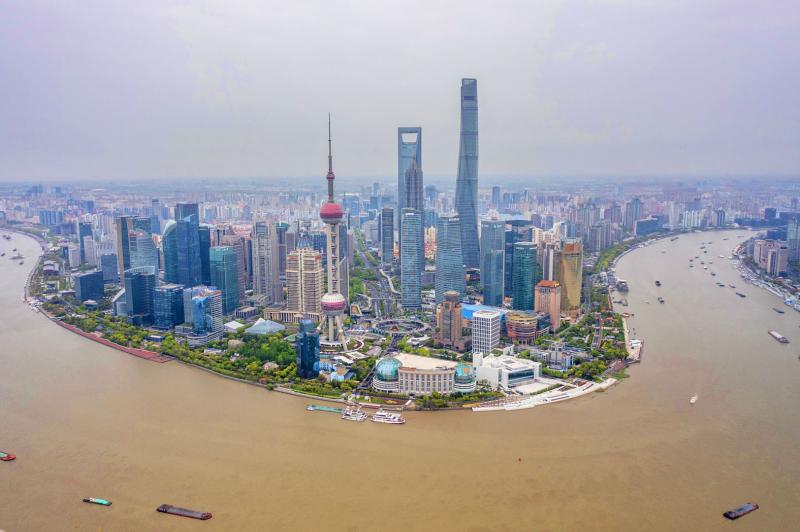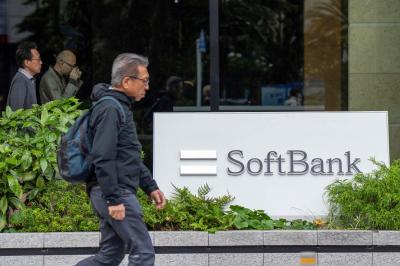China’s economic recovery quickened sharply in the first quarter from last year’s deep COVID-19 slump, propelled by stronger demand at home and abroad, and continued government support for smaller firms.
However, the brisk expansion, heavily skewed by the plunge in activity a year earlier, is expected to moderate later this year, as the government turns its attention to reining in financial risks in overheating parts of the economy.
GDP jumped 18.3 percent in the first quarter from a year earlier, official data showed yesterday.

Photo: EPA-EFE
While that undershot the 19 percent forecast by economists in a Reuters poll, it was the fastest growth since quarterly records began in 1992 and up from 6.5 percent in the fourth quarter last year.
“The upshot is that with the economy already above its pre-virus trend and policy support being withdrawn, China’s post-COVID rebound is leveling off,” Capital Economics senior China economist Julian Evans-Pritchard said. “We expect quarter-on-quarter growth to remain modest during the rest of this year as the recent boom in construction and exports unwinds, pulling activity back towards trend.”
Aided by strict virus containment measures and emergency relief for businesses, the economy has recovered from a steep 6.8 percent slump in the first three months of last year, when an outbreak of COVID-19 in Wuhan rapidly became a crippling pandemic that has killed about 3 million worldwide.
China’s rebound has been led by exports as factories raced to fill overseas orders and more recently a steady pickup in consumption, as shoppers returned to restaurants, malls and auto dealerships.
Retail sales increased 34.2 percent year-on-year last month, beating a 28 percent gain expected by analysts and stronger than the 33.8 percent jump seen in the first two months of the year.
However, other data showed a moderation in expansion with sequential growth slowing to 0.6 percent in January-March from a revised 3.2 percent in the previous quarter, missing expectations for a 1.5 percent increase.
Factory output grew 14.1 percent year-on-year last month, slowing from a 35.1 percent surge in the January-February period and lagging a forecast 17.2 percent rise.
Chinese National Bureau of Statistics spokeswoman Liu Aihua (劉愛華) told a news conference yesterday that while the economy started the year on a firm footing, the services sector and smaller firms still faced challenges, while consumer inflation was likely to remain moderate.
Data last week showed that consumer prices rising at only a modest pace last month, even as factory gate inflation hit a near three-year high.
“The trend of normalization may continue for the rest of the year, and domestic consumption is expected to be the major growth driver,” said Chaoping Zhu (朱超平), global market strategist at JP Morgan Asset Management in Shanghai. “In terms of policy response, the central bank and fiscal authorities are returning to a more neutral stance, although some selective measures might be continued in order to support the small and medium-sized enterprises.”
Li Wei (李煒), senior China economist at Standard Chartered in Shanghai, expected second-quarter growth to slow to 7 percent.
The world’s second-largest economy is expected to grow 8.6 percent this year, according to a Reuters poll, which would easily beat the government’s annual growth target of above 6 percent.
China’s GDP grew just 2.3 percent rise last year, its weakest expansion in 44 years, but still making it the only major economy to avoid contraction as other industrial powers struggled with the COVID-19 pandemic hit.

PERSISTENT RUMORS: Nvidia’s CEO said the firm is not in talks to sell AI chips to China, but he would welcome a change in US policy barring the activity Nvidia Corp CEO Jensen Huang (黃仁勳) said his company is not in discussions to sell its Blackwell artificial intelligence (AI) chips to Chinese firms, waving off speculation it is trying to engineer a return to the world’s largest semiconductor market. Huang, who arrived in Taiwan yesterday ahead of meetings with longtime partner Taiwan Semiconductor Manufacturing Co (TSMC, 台積電), took the opportunity to clarify recent comments about the US-China AI race. The Nvidia head caused a stir in an interview this week with the Financial Times, in which he was quoted as saying “China will win” the AI race. Huang yesterday said

Japanese technology giant Softbank Group Corp said Tuesday it has sold its stake in Nvidia Corp, raising US$5.8 billion to pour into other investments. It also reported its profit nearly tripled in the first half of this fiscal year from a year earlier. Tokyo-based Softbank said it sold the stake in Silicon Vally-based Nvidia last month, a move that reflects its shift in focus to OpenAI, owner of the artificial intelligence (AI) chatbot ChatGPT. Softbank reported its profit in the April-to-September period soared to about 2.5 trillion yen (about US$13 billion). Its sales for the six month period rose 7.7 percent year-on-year

MORE WEIGHT: The national weighting was raised in one index while holding steady in two others, while several companies rose or fell in prominence MSCI Inc, a global index provider, has raised Taiwan’s weighting in one of its major indices and left the country’s weighting unchanged in two other indices after a regular index review. In a statement released on Thursday, MSCI said it has upgraded Taiwan’s weighting in the MSCI All-Country World Index by 0.02 percentage points to 2.25 percent, while maintaining the weighting in the MSCI Emerging Markets Index, the most closely watched by foreign institutional investors, at 20.46 percent. Additionally, the index provider has left Taiwan’s weighting in the MSCI All-Country Asia ex-Japan Index unchanged at 23.15 percent. The latest index adjustments are to

CRESTING WAVE: Companies are still buying in, but the shivers in the market could be the first signs that the AI wave has peaked and the collapse is upon the world Taiwan Semiconductor Manufacturing Co (TSMC, 台積電) yesterday reported a new monthly record of NT$367.47 billion (US$11.85 billion) in consolidated sales for last month thanks to global demand for artificial intelligence (AI) applications. Last month’s figure represented 16.9 percent annual growth, the slowest pace since February last year. On a monthly basis, sales rose 11 percent. Cumulative sales in the first 10 months of the year grew 33.8 percent year-on-year to NT$3.13 trillion, a record for the same period in the company’s history. However, the slowing growth in monthly sales last month highlights uncertainty over the sustainability of the AI boom even as